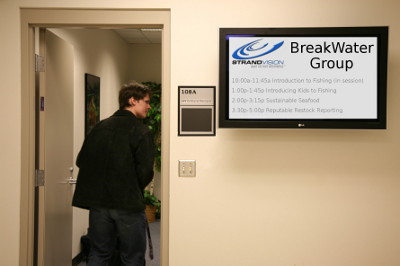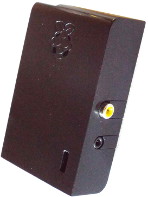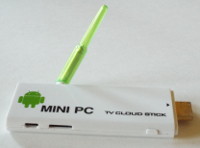StrandVision Digital Signage
715-235-SIGN (7446) | www.StrandVision.com
- Home
- News & Events
- Articles
- Digital Signage Meeting and Event "Reader Boards" Are Within Reach
Digital Signage Meeting and Event "Reader Boards" Are Within Reach
By Mike Strand, Founder & CEO, StrandVision
You know those signs that you see outside of meeting rooms showing who's meeting? You see them in hotels, restaurants, corporate offices, municipal buildings, colleges, churches - anywhere there are frequent meetings. Well, they're often called "Reader Boards" and they're a pain to keep up-to-date and accurate.
Large hotels and companies have been able to spend the money to assign staff or invest in technology to take care of their reader boards. For smaller organizations, though, reader boards are a thorn in the side that often don't look as good as they should and require constant attention - until now.
Recently, digital signage, also call electronic signage, has come down in price and increased in ease-of-use to the point where a simple digital signage installation can solve the reader board problem for virtually any organization. It goes without saying that StrandVision can provide this solution but I'll describe a generic system to show how you can easily and quickly implement a reader board network.
One Summary Display - A Display at Every Room
Let's take a small hotel as an example to demonstrate how a digital signage reader board can be used in virtually any situation. Imagine a hotel with six meeting rooms. The ideal would be to have a display in the lobby that is automatically updated daily (or more often) showing the meetings and times for all of the rooms that are being used by what group and maybe the topic of the presentation. The display could show all at once or scroll through the listing. It can be organized to indicate all of the scheduled events for the hotel or just a specific group (say, BreakWater Group). It could even include a room finder diagram. This lobby display would greet guests as they arrive to direct them to the proper room. The same information can also be shown on the in-room cable system.
 Then, outside of each of the six rooms, there would be an electronic display that only would show what was scheduled for that particular room. It could display the same information or have more information, such as the presenters, etc. This information would be driven from the same network but would automatically select only that room's schedule and information. The digital signage displays in the lobby and outside the individual rooms could also provide other pages of information, such as promotions for the hotel restaurant, the weather, company slogans and logos.
Then, outside of each of the six rooms, there would be an electronic display that only would show what was scheduled for that particular room. It could display the same information or have more information, such as the presenters, etc. This information would be driven from the same network but would automatically select only that room's schedule and information. The digital signage displays in the lobby and outside the individual rooms could also provide other pages of information, such as promotions for the hotel restaurant, the weather, company slogans and logos.
Technically, all of this can be done today and I'll explain how later. The real key to a successful, useful reader board network is to have accurate, timely information that is automatically provided to the displays.
Real Time Updating
The solution is to tie the reader board network to a scheduling database and have the signage network frequently poll the database for updates. This can be as often as every minute. At StrandVision our systems are designed to accept any RSS feed (a standard information sharing protocol) so we can customize our system to work with high-end room reservation/scheduling software. We actually do that for some large hotel chains.
But, most hotels, schools and other organizations don't use that kind of expensive, sophisticated software so we've designed our system to link to Google Calendar, a free scheduler that's available on the Web. Any event that's entered into Google Calendar can automatically be shown on the reader board system. The hotel clerk simply adds the meeting to the schedule at the time of booking - it can even be months or years ahead - and the meeting will automatically appear on the proper reader boards at the right time. If there's a schedule change or cancellation an update to the Google Calendar is automatically picked up by the reader board system. It couldn't be easier. Your meeting schedule becomes your display schedule; and remember, you can mix in ads, weather or other information.
Getting the Information Out
You may think that's all well and good but I don't have a wired network in place to reach all of my rooms for the individual displays. That's also been largely addressed by advancing technology. Today, with the advent of digital televisions, tablets and even electronic picture frames there are a host of attractive, inexpensive room display options. Any display unit that has a High-Definition Multimedia Interface (HDMI) video input, and most displays available today do, can become a wireless StrandVision Digital Signage display. You can do this by attaching a personal computer to the display.
 "A PC!" you say. "I'm not going to put a PC in the hallway outside of my rooms! It's ugly and too expensive!" Well, we're not talking about a traditional PC or even a notebook. Today there are credit-card-sized PCs that are wireless and are powerful enough to handle reader boards. (Think the open source Raspberry Pi, Google's Chromecast or Amazon's Fire TV.) These units are incredibly small and, when programmed properly, handle specific tasks, such as digital signage, very well.
"A PC!" you say. "I'm not going to put a PC in the hallway outside of my rooms! It's ugly and too expensive!" Well, we're not talking about a traditional PC or even a notebook. Today there are credit-card-sized PCs that are wireless and are powerful enough to handle reader boards. (Think the open source Raspberry Pi, Google's Chromecast or Amazon's Fire TV.) These units are incredibly small and, when programmed properly, handle specific tasks, such as digital signage, very well.
 Picture a wall mounted display screen. That's it. You won't even see the HDMI player. We supply HDMI computers that are preloaded with our digital signage software. It's just a matter of mounting the display, plugging in the HDMI computer and logging onto the wireless network. That takes care of the individual rooms.
Picture a wall mounted display screen. That's it. You won't even see the HDMI player. We supply HDMI computers that are preloaded with our digital signage software. It's just a matter of mounting the display, plugging in the HDMI computer and logging onto the wireless network. That takes care of the individual rooms.
So, you end up with a lobby display that shows everything and individual room displays for each of the meeting rooms. Also, once you have the information available for the reader board network you can also show the schedule as part of a page mix on in-room and other employee or visitor-facing digital signage systems.
Think of the Possibilities
All of this is possible today. And there are many different venues that can use these reader board capabilities:
Restaurants - Use a reader board at the entrance to automatically show the menu being served (breakfast, lunch, dinner) throughout the day. Show daily specials. Display updated weather, ads for nearby retailers, etc.
Corporate offices - Display meeting schedules for the conference center. Manage individual meeting rooms in the center and throughout the campus without having to update each room manually. You can even post notices at the rooms directing people to other locations if the room has changed or the meeting is rescheduled. The displays for unscheduled rooms can be used for employee notices of upcoming employee benefits deadlines or meetings, etc. Meeting schedules can be posted to employee intranet sites.
Public meetings - Administrators of any building that hosts public meetings, such as state and local government buildings, libraries, colleges and churches can use the Google Calendars capabilities to inexpensively install a professional looking reader board system. It'll cut down on confusion and make it easier to manage the entire room scheduling process.
For further information on reader board digital singe networks contact Mike Strand at mjstrandweb at StrandVision.com or call 715-235-SIGN (7446).
Mike Strand is founder and CEO of StrandVision LLC, an Internet-based subscription digital signage service that is distributed through resellers. Previously, Mike founded StrandWare, a leading bar code software and AIDC company. Anyone with questions can contact Mike at mjstrandweb at StrandVision.com.